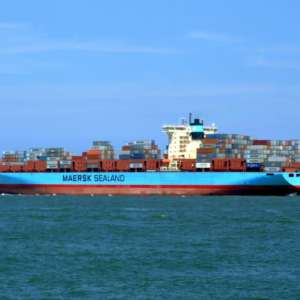In the weeks since the US and China released their dueling lists of tariffs, the world has gotten a glimpse of just how delicate and complex our supply chains have become. The US had already imposed steep tariffs on imported steel and aluminum, then specifically targeted China with heavy machinery, medicine, and 1,300 other items. A day later, China retaliated with a 106 item-long list that includes soy, tobacco, whiskey, beef, and cars. Despite the efforts of the Trump Administration to impose import tariffs in ways that primarily target manufacturers, rather than consumers, economists and business owners are already sounding the alarm that the tariffs stand to cost jobs, increase prices, and create ripple effects that could disrupt the economy in unintended ways.
We can get an idea of how tariffs impact modern supply chains by looking at steel, where prices have already spiked, driven by the mere threat of tariffs. The Federal Reserve issued a report stating that domestic manufacturers planned to absorb half the price increase as a loss in profit and pass the rest on to customers. For small companies, this hike could stifle growth or even put them out of business. Multinational corporations, meanwhile, are more likely to simply move production overseas. These were clearly not the intended outcomes for a tariff meant to support US Steel, but industries cannot simply wean themselves off cheap raw materials overnight. According to Laura Baughman, president of Trade Partnership, an economic consulting firm, tariffs will increase domestic steel and aluminum employment by roughly 26,000 jobs, but still end up costing the economy 495,000 jobs downstream, not only in manufacturing, but in construction, sales, and service. Particularly in specialized manufacturing such as automotive and industrial equipment, which need high-grade steel, switching suppliers is a time-consuming process, and Goldman Sachs has estimated that GM and Ford stand to lose $1 billion this year alone from the cost of the tariffs.
These are clear implications of a single tariff item. Once you combine it with others, the consequences multiply. Take for example a soybean farmer accustomed to exporting her crop to China, which included soy on its list of retaliatory tariffs. That farmer won’t be investing in new, American-made farm equipment this year, especially since steel prices have just increased.
These aren’t just hypotheticals. The Wall Street Journal reports that truckers are now paying more for new trailers at a time when capacity is already tight, and businesses are stockpiling raw materials and seeking to extend their credit lines. Trade war anxiety has real effects, even though these tariffs may never come to pass. It’s possible, even probable, that the US and China are merely posturing to secure better terms, but yelling “fire” in a crowded theater can have devastating consequences regardless of whether or not the fire exists.
Most Americans, even those who consider themselves conservative in matters of trade, can appreciate how disruptive these tariffs are likely to be. According to the Wall Street Journal, “A recent survey found more than one-third of small-business owners believe tariffs will hurt their businesses, while just 5% said they would benefit.” Giant conglomerates agree, with Apple CEO Tim Cook reportedly imploring President Trump to reconsider any action that would disrupt its multinational supply chain, which runs from California to China. Petrochemical companies who had planned to increase US operations in anticipation of increased Chinese demand for plastics are equally alarmed. Ocean carriers see the tariffs as impacting nearly 7 percent of US container trade with China, which could damage shipping’s nascent recovery and drive prices up. According to Drewry, should “the situation become real, we would clearly have to revise our demand forecasts downward.”
The merits of globalized free trade are debatable, but they have governed US policy for decades, and the world’s largest economies cannot turn on a dime. While creating a self-sufficient American manufacturing climate sounds appealing, it is likely to result in small companies straining to absorb the cost, and large companies moving overseas. We have now reached a point where attempting to make supply chains simpler may be the most complicated challenge of all.



